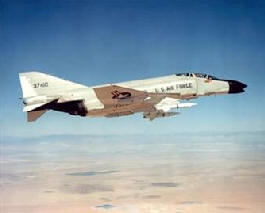 |
|
January 13, 2010 - The Vietnam War, also known as the Second Indochina
War, was a Cold War military conflict that occurred in
Vietnam,
Laos, and Cambodia from
September 26, 1959 to April 30, 1975. Officials with the Department of
Defense POW Missing Personnel Office announced January 12, 2010, that
the remains of an Air Force pilot, missing in action from the Vietnam
War, have been identified and will be returned to his family for burial.
Maj. Russell C. Goodman of Salt Lake City,
Utah, will be honored at Nellis Air Force Base,
Nev., home of the U.S. Air Force Thunderbird
demonstration team. At the time he was lost, Major Goodman was assigned
to the Thunderbirds and was flying with the U.S. Navy on an exchange
program. He will be buried in Alaska at a date determined by his family.
On Feb. 20,
1967, Major Goodman and Navy Lt. Gary L. Thornton took off in their F-4B
Phantom from the USS Enterprise for a bombing mission against a railroad
yard in Thanh Hoa Province,
North Vietnam. They were struck by
enemy antiaircraft fire and their plane exploded. Lieutenant Thornton
was able to eject at just 250 feet altitude, but Major Goodman did not
escape. Lieutenant Thornton survived and was held captive until his
release in 1973.
|
|
Search and rescue attempts were curtailed because of heavy anti-aircraft
and automatic weapons fire in the area of the crash. Between
October 1993 and March 2008, joint U.S.-Vietnamese teams led by the
Joint POW MIA Accounting Command investigated the crash site twice and
conducted two excavations, recovering human remains and pilot equipment.
The aircraft debris recovered correlates with the type of aircraft the
men were flying.
Among other forensic identification tools and circumstantial evidence,
scientists from JPAC and the Armed Forces DNA Identification Laboratory
also used mitochondrial DNA, which matched two of his maternal
relatives, in the identification of Goodman's remains.
The Vietnam War
was fought between the communist North Vietnam, supported by its communist allies,
and the government of South Vietnam,
supported by the
United States and other anti-communist
nations.
The Viet
Cong, a lightly armed South Vietnamese communist-controlled common
front, largely fought a guerrilla war against anti-communist forces in
the region. The North Vietnamese Army engaged in a more conventional
war, at times committing large units into battle. U.S. and South
Vietnamese forces relied on air superiority and overwhelming firepower
to conduct search and destroy operations, involving ground forces,
artillery and airstrikes.
|


